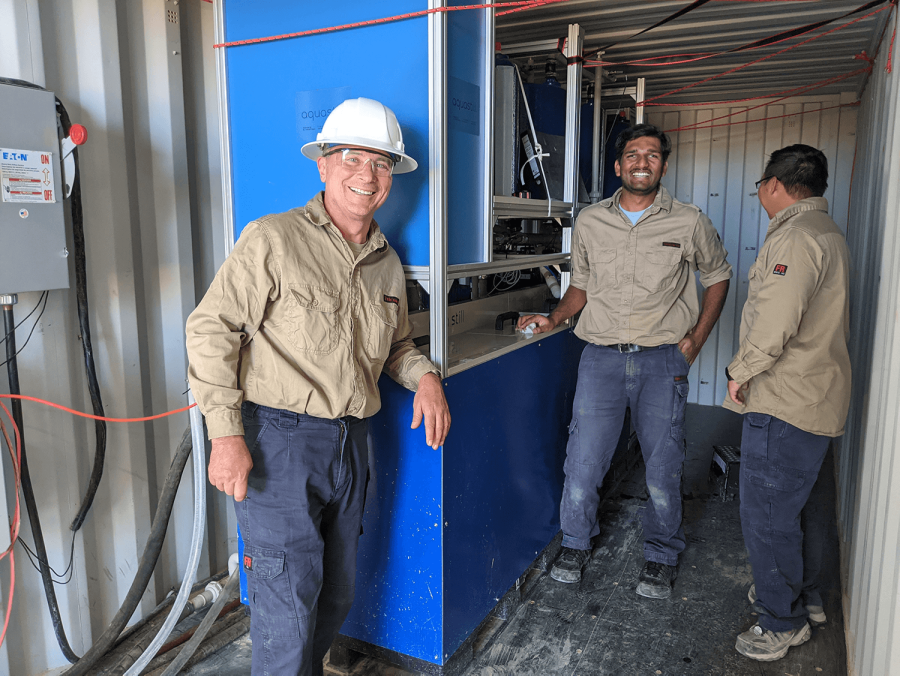Pitt Engineering develops new process to recycle oil and gas wastewater
Image via Swanson Engineering webpage
Radisav Vidic, left, Ritesh Pawar and Zheiwei “Joey” Zhang working on the pilot-scale MD system in Texas.
July 15, 2022
With sustainability in mind, Pitt Engineering designed a system to curb energy industry water waste through membrane distillation. Radisav Vidic, the project’s leader, said it’s “important” to come up with strategies to combat the environmental impact of fracking and oil production.
“It is of critical importance to develop alternative strategies for the management of produced water that would reduce the overall cost, allow recovery of valuable resources and reduce the environmental footprint of this industry,” Vidic, professor of engineering and chair of the Department of Civil and Environmental Engineering said to the Swanson School of Engineering Virtual Newsroom. “Right now, the industry is not being presented with financially feasible options. This project proves that those options can and do exist.”
According to Duke University, as many as 250 million barrels of water are wasted per day by the oil and gas industry in the U.S. — over three times the amount of oil per gallon produced in the same span. The water, though not safe for human consumption, has the potential to balance hydrologic cycles and could be reused by the energy and agriculture industries, according to the Swanson School Virtual Newsroom. Testing for the project has occurred both in the lab and field in Texas, North Dakota and Pennsylvania.
According to Vidic, almost all water used in fracking or energy production in Pennsylvania is put into a disposal well and lost permanently from the ecosystem. These wells are located in Ohio, where thousands of gallons of water are dumped at a cost of $16 million per year.
Vidic describes membrane distillation as similar to reverse osmosis — a process where water is purified by heating water and allowing the subsequent vapor to be moved through a filter. In membrane distillation, a hydrophobic membrane — a membrane that does not allow water to pass — acts as a filter while waste heat, produced by the large machines used in energy production, pushes steam through. Through this process, the wastewater turns into usable water.
Eight years in the making, the project initially began on paper with fundamental chemistry and theoretical calculations performed by doctoral students and Vidic. Though many university research programs end after publication, Vidic’s curiosity led it beyond.
“I was curious to find out if this thing can work in a real situation, and that’s why I was pushing to do the pilot-scale demonstration to see if that’s going to work,” Vidic said. “I think it’s worthwhile in order to push the technology further.”
As a result, the team had a pilot unit built inside a 20-foot shipping container in the Netherlands, which was then disassembled and shipped to Texas for testing, the funding for which came from the Department of Energy in 2018 as part of a $5.3 million dollar award spread across collaborating universities — most of which were also in Texas.
While a program like this would cut down on cost and emissions, Vidic said its technology is not new. According to Vidic, membranes like this have been around since the 70s.
“The membranes that were available at that time were not as robust and were not as permeable,” Vidic said. “10 years ago … new membranes came on the market,” he said, allowing researchers to “try it under more challenging conditions.”
Only with recent improvements to the old technology was a project like this possible. But the team, according to Vidic, still ran into issues with their membranes, which needed to be wet in order to prevent the wastewater from passing through without filtering. Surfactants, or detergents, are often used in such membranes to keep them wet. But these components also weigh down membranes and cause other unwanted particles to enter into the purified water, according to Vidic.
Despite these setbacks, Vidic and his team are working with carbon absorption to eliminate their surfactant issue.
“We’ve done tests in the lab that indicate that if we take this water and pass it through just a carbon column … they [surfactants] will get out of water and they will attach to the carbon particles and stay there and the clean water will go through,” Vidic said.
Doctoral candidate Ritesh Pawar believes there’s plenty to be excited about and said he was thrilled to work on a project of this scope.
“All of us do everything at the lab, but not everything gets to the actual field,”Pawar said. “So it was kind of interesting, and I look forward to being a part of the same field or like a water treatment-related field in the future.”
Pawar, who spent the last three years working with Vidic on the project, isn’t the only one excited about the program and was invited to attend a conference in Houston with the Produced Water Society.
”They were really interesting. They gave me a scholarship for continuing my work in the same field,” Pawar said.
But Pawar believes the industry will remain hesitant on this new technology for a while yet.
“I’m still concerned about the commercialization of this, since nobody wants to have a physical setup when the technology is not proven beforehand,” Pawar said.
Pawar’s fellow program partner and doctoral candidate Zheiwei “Joey” Zhang also expressed gratitude and enthusiasm about working at a fundamental level.
“It really helped me to relate my research work to the industry… Practical experience is important for my future career as an engineer,” Zhang said.
Zhang said the program has “great potential” for the future.
“I think this technology has a great future although I believe that doesn’t really tell you that energy consumption is a problem,” Zhang said. “Right now it may not be that good, but in the future it has a great potential of being the major or mainstream salination technology.”








